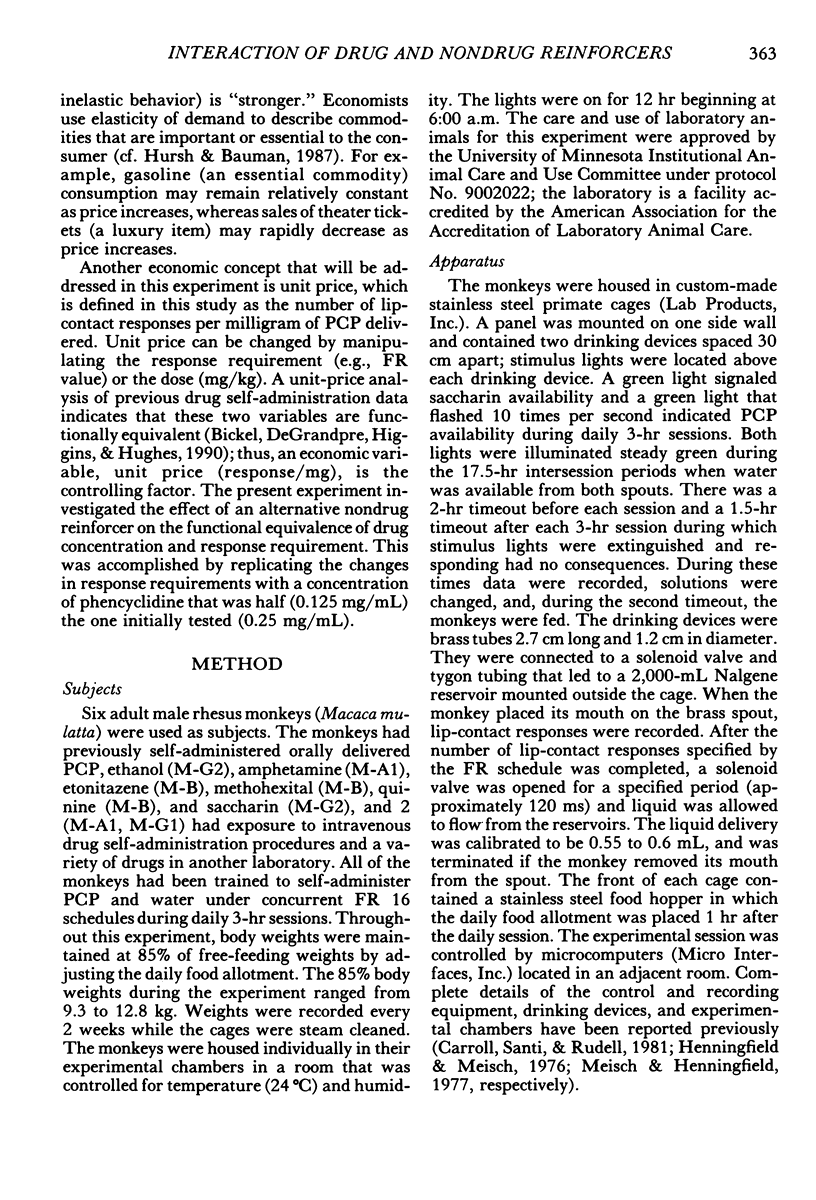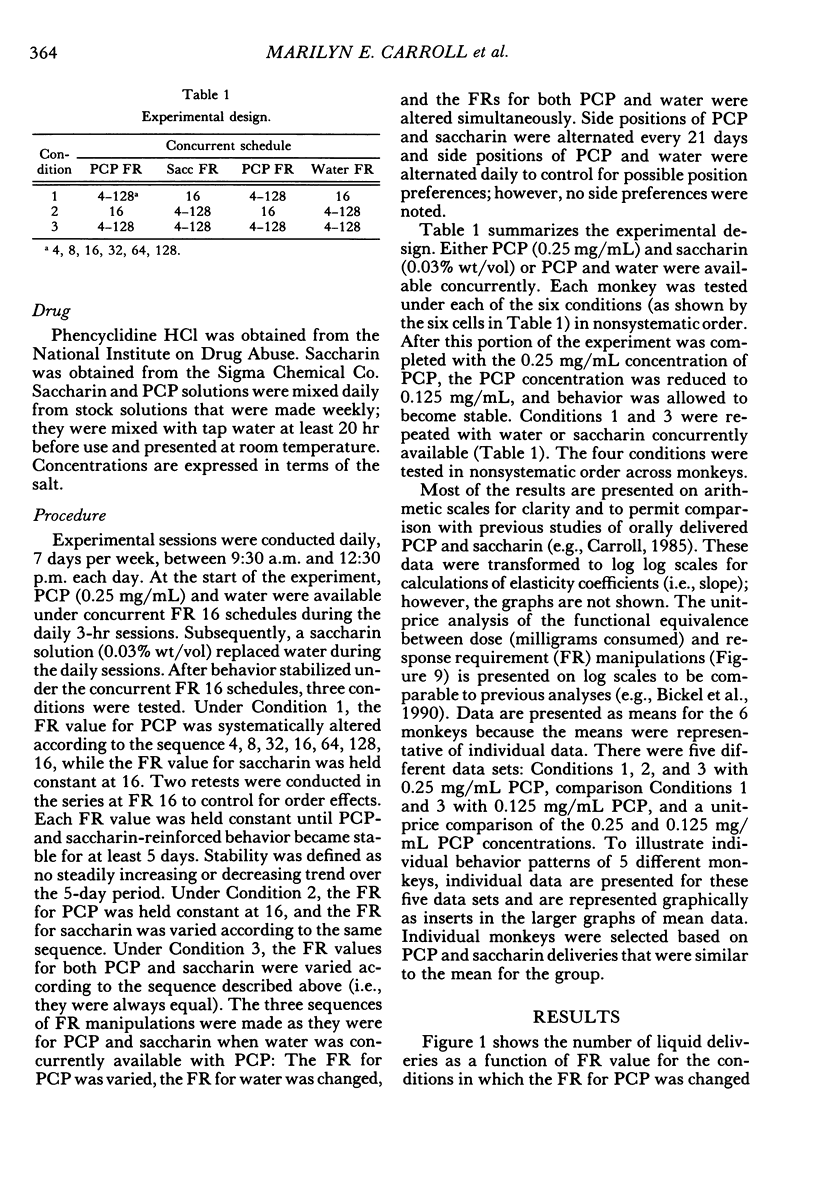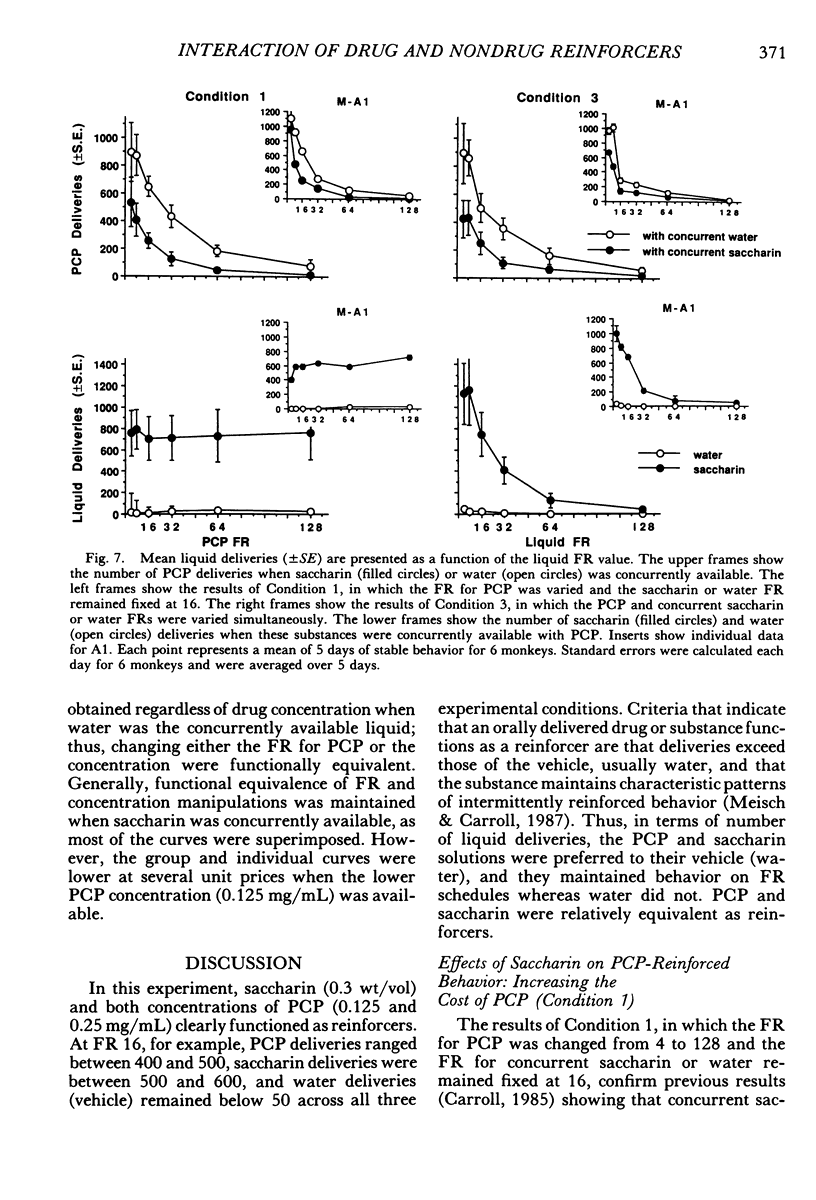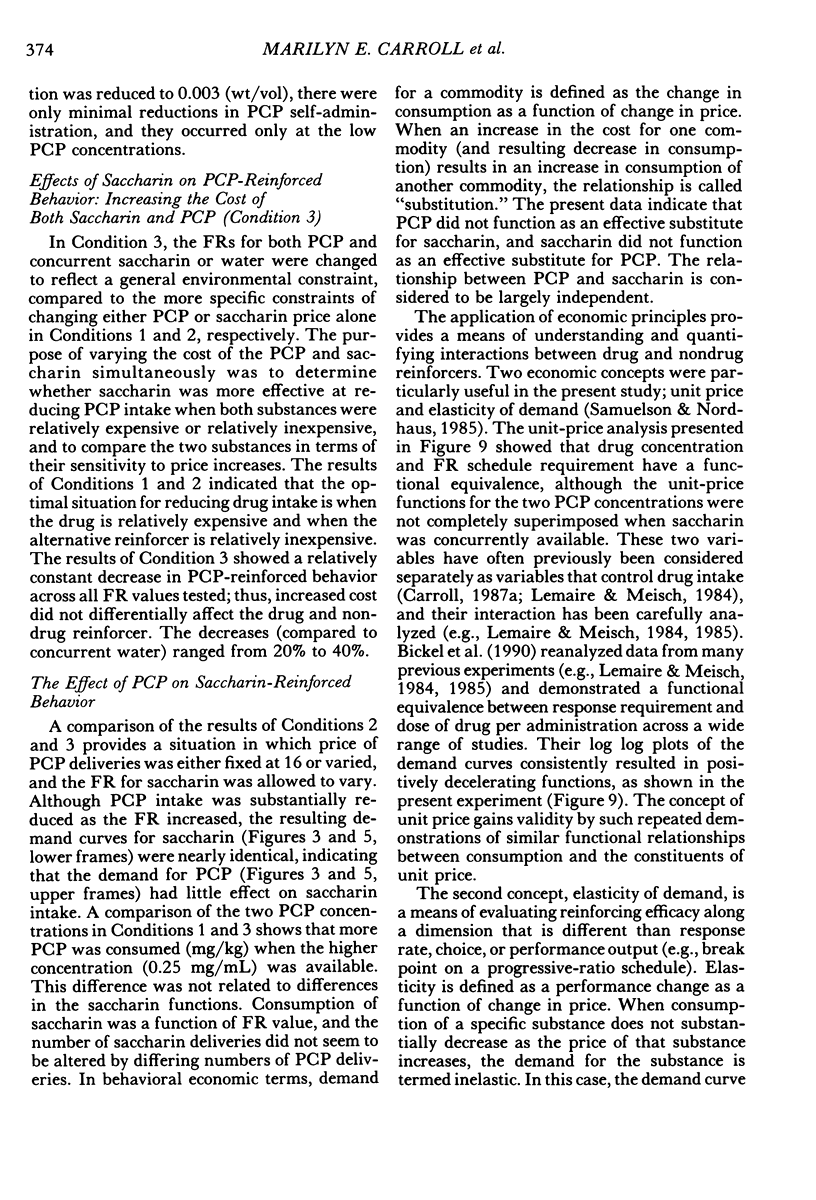Abstract
Six rhesus monkeys were trained to self-administer orally delivered phencyclidine (0.25 mg/mL) and saccharin (0.03% wt/vol) under concurrent fixed-ratio 16 schedules. In Condition 1 the fixed-ratio requirement for phencyclidine was changed from 16 to 4, 8, 16, 32, 64, 128 and 16 while the fixed-ratio requirement for saccharin deliveries remained constant at 16. In Condition 2 the fixed-ratio value for saccharin was systematically altered while the fixed-ratio requirement for phencyclidine remained at 16, and in Condition 3 the fixed-ratio requirements for both phencyclidine and saccharin were altered simultaneously. Water was then substituted for saccharin, and the series of fixed-ratio manipulations was replicated. The phencyclidine concentration was reduced to 0.125 mg/mL and Conditions 1 and 3 were repeated. When the fixed-ratio requirement for phencyclidine was increased and the fixed-ratio requirement for saccharin or water remained fixed at 16, phencyclidine deliveries decreased when saccharin (vs. water) was concurrently available. The magnitude of the decrease ranged from 20% to 90% (of the concurrent water condition) as the fixed-ratio requirement for phencyclidine increased from 4 to 128. When the fixed-ratio requirement for phencyclidine remained at 16 and the fixed-ratio requirements for concurrent saccharin or water varied between 4 and 128, phencyclidine deliveries decreased by 30% to 40% due to the concurrent availability of saccharin (vs. water). This decrease occurred only at the three lowest fixed-ratio values when saccharin intake was relatively high. When the fixed-ratio requirements for both phencyclidine and concurrent saccharin or water were varied simultaneously, phencyclidine deliveries were reduced from 20% to 45% when saccharin (vs. water) was concurrently present. There was little effect of reducing the phencyclidine concentration when the data were analyzed in terms of unit price (responses per milligram). Thus, changes in the fixed-ratio requirement or drug concentration were functionally similar, and unit price of phencyclidine was the variable that was influenced by the presence of concurrent saccharin. These data indicate that drug-reinforced behavior is substantially reduced when the environment is enriched with an alternative nondrug reinforcer. The economic context in which these substances are presented is an important determinant of drug-reinforced behavior.
Full text
PDF















Selected References
These references are in PubMed. This may not be the complete list of references from this article.
- Bickel W. K., DeGrandpre R. J., Higgins S. T., Hughes J. R. Behavioral economics of drug self-administration. I. Functional equivalence of response requirement and drug dose. Life Sci. 1990;47(17):1501–1510. doi: 10.1016/0024-3205(90)90178-t. [DOI] [PubMed] [Google Scholar]
- Carroll M. E., Carmona G. Effects of food FR and food deprivation on disruptions in food-maintained performance of monkeys during phencyclidine withdrawal. Psychopharmacology (Berl) 1991;104(2):143–149. doi: 10.1007/BF02244169. [DOI] [PubMed] [Google Scholar]
- Carroll M. E. Concurrent access to two concentrations of orally delivered phencyclidine: effects of feeding conditions. J Exp Anal Behav. 1987 May;47(3):347–362. doi: 10.1901/jeab.1987.47-347. [DOI] [PMC free article] [PubMed] [Google Scholar]
- Carroll M. E. Concurrent phencyclidine and saccharin access: presentation of an alternative reinforcer reduces drug intake. J Exp Anal Behav. 1985 Jan;43(1):131–144. doi: 10.1901/jeab.1985.43-131. [DOI] [PMC free article] [PubMed] [Google Scholar]
- Carroll M. E., Lac S. T., Nygaard S. L. A concurrently available nondrug reinforcer prevents the acquisition or decreases the maintenance of cocaine-reinforced behavior. Psychopharmacology (Berl) 1989;97(1):23–29. doi: 10.1007/BF00443407. [DOI] [PubMed] [Google Scholar]
- Carroll M. E., Santi P. A., Rudell R. L. A microcomputer system for the control of behavioral experiments. Pharmacol Biochem Behav. 1981 Mar;14(3):415–417. doi: 10.1016/0091-3057(81)90411-1. [DOI] [PubMed] [Google Scholar]
- Carroll M. E. Self-administration of orally-delivered phencyclidine and ethanol under concurrent fixed-ratio schedules in rhesus monkeys. Psychopharmacology (Berl) 1987;93(1):1–7. doi: 10.1007/BF02439578. [DOI] [PubMed] [Google Scholar]
- Carroll M. E., Stitzer M. L., Strain E., Meisch R. A. The behavioral pharmacology of alcohol and other drugs. Emerging issues. Recent Dev Alcohol. 1990;8:5–46. [PubMed] [Google Scholar]
- Carroll M. E., Stotz D. C. Increased phencyclidine self-administration due to food deprivation: interaction with concentration and training conditions. Psychopharmacology (Berl) 1984;84(3):299–303. doi: 10.1007/BF00555202. [DOI] [PubMed] [Google Scholar]
- Dworkin S. I., Guerin G. F., Goeders N. E., Cherek D. R., Lane J. D., Smith J. E. Reinforcer interactions under concurrent schedules of food, water, and intravenous morphine. Psychopharmacology (Berl) 1984;82(4):282–286. doi: 10.1007/BF00427670. [DOI] [PubMed] [Google Scholar]
- Hall S. M., Ginsberg D., Jones R. T. Smoking cessation and weight gain. J Consult Clin Psychol. 1986 Jun;54(3):342–346. doi: 10.1037//0022-006x.54.3.342. [DOI] [PubMed] [Google Scholar]
- Hatsukami D. K., Hughes J. R., Pickens R. W., Svikis D. Tobacco withdrawal symptoms: an experimental analysis. Psychopharmacology (Berl) 1984;84(2):231–236. doi: 10.1007/BF00427451. [DOI] [PubMed] [Google Scholar]
- Henningfield J. E., Meisch R. A. Drinking device for rhesus monkeys. Pharmacol Biochem Behav. 1976 May;4(5):609–610. doi: 10.1016/0091-3057(76)90204-5. [DOI] [PubMed] [Google Scholar]
- Hoffman S. H., Branch M. N., Sizemore G. M. Cocaine tolerance: acute versus chronic effects as dependent upon fixed-ratio size. J Exp Anal Behav. 1987 May;47(3):363–376. doi: 10.1901/jeab.1987.47-363. [DOI] [PMC free article] [PubMed] [Google Scholar]
- Hursh S. R. Economic concepts for the analysis of behavior. J Exp Anal Behav. 1980 Sep;34(2):219–238. doi: 10.1901/jeab.1980.34-219. [DOI] [PMC free article] [PubMed] [Google Scholar]
- LESTER D., GREENBERG L. A. Nutrition and the etiology of alcoholism; the effect of sucrose, saccharin and fat on the self-selection of ethyl alcohol by rats. Q J Stud Alcohol. 1952 Dec;13(4):553–560. [PubMed] [Google Scholar]
- Lemaire G. A., Meisch R. A. Oral drug self-administration in rhesus monkeys: interactions between drug amount and fixed-ratio size. J Exp Anal Behav. 1985 Nov;44(3):377–389. doi: 10.1901/jeab.1985.44-377. [DOI] [PMC free article] [PubMed] [Google Scholar]
- Lemaire G. A., Meisch R. A. Pentobarbital self-administration in rhesus monkeys: drug concentration and fixed-ratio size interactions. J Exp Anal Behav. 1984 Jul;42(1):37–49. doi: 10.1901/jeab.1984.42-37. [DOI] [PMC free article] [PubMed] [Google Scholar]
- Meisch R. A., Henningfield J. E. Drinking of ethanol by rhesus monkeys: experimental strategies for establishing ethanol as a reinforcer. Adv Exp Med Biol. 1977;85B:443–463. doi: 10.1007/978-1-4615-9038-5_29. [DOI] [PubMed] [Google Scholar]
- Nevin J. A. Response strength in multiple schedules. J Exp Anal Behav. 1974 May;21(3):389–408. doi: 10.1901/jeab.1974.21-389. [DOI] [PMC free article] [PubMed] [Google Scholar]
- Oei T. P., Singer G., Jefferys D. The interaction of a fixed time food delivery schedule and body weight on self-administration of narcotic analgesics. Psychopharmacology (Berl) 1980 Feb;67(2):171–176. doi: 10.1007/BF00431973. [DOI] [PubMed] [Google Scholar]
- Samson H. H., Falk J. L. Alteration of fluid preference in ethanol-dependent animals. J Pharmacol Exp Ther. 1974 Aug;190(2):365–376. [PubMed] [Google Scholar]
- Samson H. H., Roehrs T. A., Tolliver G. A. Ethanol reinforced responding in the rat: a concurrent analysis using sucrose as the alternate choice. Pharmacol Biochem Behav. 1982 Aug;17(2):333–339. doi: 10.1016/0091-3057(82)90088-0. [DOI] [PubMed] [Google Scholar]
- Takahashi R. N., Singer G., Oei T. P. Schedule induced self-injection of D-amphetamine by naive animals. Pharmacol Biochem Behav. 1978 Dec;9(6):857–861. doi: 10.1016/0091-3057(78)90369-6. [DOI] [PubMed] [Google Scholar]
- Vuchinich R. E., Tucker J. A. Behavioral theories of choice as a framework for studying drinking behavior. J Abnorm Psychol. 1983 Nov;92(4):408–416. doi: 10.1037//0021-843x.92.4.408. [DOI] [PubMed] [Google Scholar]
- Yung L., Gordis E., Holt J. Dietary choices and likelihood of abstinence among alcoholic patients in an outpatient clinic. Drug Alcohol Depend. 1983 Dec;12(4):355–362. doi: 10.1016/0376-8716(83)90007-8. [DOI] [PubMed] [Google Scholar]
- de la Garza R., Johanson C. E. The effects of food deprivation on the self-administration of psychoactive drugs. Drug Alcohol Depend. 1987 Jan;19(1):17–27. doi: 10.1016/0376-8716(87)90083-4. [DOI] [PubMed] [Google Scholar]


